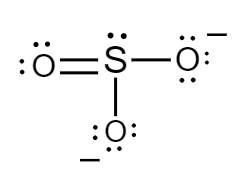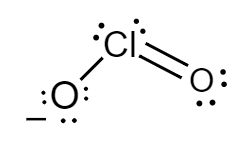
What are the formal charges on each atom in sulphite,
Answer
426k+ views
Hint: Formal charge is a theoretical value assigned to an atom in a molecule which reflects the equal sharing of electrons in a chemical bond, neglecting the electronegativity difference between the atoms. Sketch the Lewis diagram for the given ions to find the value of formal charge of each atom.
Complete answer:
The formal charge can be assigned to an atom with the help of following formula:
Where,
The Lewis structure for sulphite ions is as follows:

Formal charge for sulphur atom:
Number of electrons of sulphur in its ground state
Count of nonbonded electrons present on sulphur atom
Number of bonding electrons
Substituting values in equation
Formal charge for doubly bonded oxygen atom:
Number of electrons of oxygen in its ground state
Count of nonbonded electrons or number of lone pair of electrons present on oxygen atom
Number of bonding electrons
Substituting values in equation
Formal charge for single bonded oxygen atoms:
Number of electrons of oxygen in its ground state
Count of nonbonded electrons or number of lone pair of electrons present on oxygen atom
Number of bonding electrons
Substituting values in equation
Hence, in sulphite ions, the formal charge of sulphur atom, doubly bonded oxygen atom and singly bonded oxygen atoms is
The Lewis structure for chlorite ions is as follows:

Formal charge for chlorine atom:
Number of electrons of chlorine in its ground state
Count of nonbonded electrons present on chlorine atom
Number of bonding electrons
Substituting values in equation
Formal charge for doubly bonded oxygen atom:
Number of electrons of oxygen in its ground state
Count of nonbonded electrons or number of lone pair of electrons present on oxygen atom
Number of bonding electrons
Substituting values in equation
Formal charge for single bonded oxygen atom:
Number of electrons of oxygen in its ground state
Count of nonbonded electrons or number of lone pair of electrons present on oxygen atom
Number of bonding electrons
Substituting values in equation
Hence, in chlorite ions, the formal charge of chlorine atom, doubly bonded oxygen atom and singly bonded oxygen atom is
Note:
Lewis structures in which the formal charges are zero for most atoms in the compound, are more preferably considered than the one with non-zero formal charges. Moreover, the negative formal charge should be present on the most electronegative element in the compound.
Complete answer:
The formal charge can be assigned to an atom with the help of following formula:
Where,
The Lewis structure for sulphite ions is as follows:

Formal charge for sulphur atom:
Number of electrons of sulphur in its ground state
Count of nonbonded electrons present on sulphur atom
Number of bonding electrons
Substituting values in equation
Formal charge for doubly bonded oxygen atom:
Number of electrons of oxygen in its ground state
Count of nonbonded electrons or number of lone pair of electrons present on oxygen atom
Number of bonding electrons
Substituting values in equation
Formal charge for single bonded oxygen atoms:
Number of electrons of oxygen in its ground state
Count of nonbonded electrons or number of lone pair of electrons present on oxygen atom
Number of bonding electrons
Substituting values in equation
Hence, in sulphite ions, the formal charge of sulphur atom, doubly bonded oxygen atom and singly bonded oxygen atoms is
The Lewis structure for chlorite ions is as follows:

Formal charge for chlorine atom:
Number of electrons of chlorine in its ground state
Count of nonbonded electrons present on chlorine atom
Number of bonding electrons
Substituting values in equation
Formal charge for doubly bonded oxygen atom:
Number of electrons of oxygen in its ground state
Count of nonbonded electrons or number of lone pair of electrons present on oxygen atom
Number of bonding electrons
Substituting values in equation
Formal charge for single bonded oxygen atom:
Number of electrons of oxygen in its ground state
Count of nonbonded electrons or number of lone pair of electrons present on oxygen atom
Number of bonding electrons
Substituting values in equation
Hence, in chlorite ions, the formal charge of chlorine atom, doubly bonded oxygen atom and singly bonded oxygen atom is
Note:
Lewis structures in which the formal charges are zero for most atoms in the compound, are more preferably considered than the one with non-zero formal charges. Moreover, the negative formal charge should be present on the most electronegative element in the compound.
Recently Updated Pages
Master Class 9 General Knowledge: Engaging Questions & Answers for Success

Master Class 9 English: Engaging Questions & Answers for Success

Master Class 9 Science: Engaging Questions & Answers for Success

Master Class 9 Social Science: Engaging Questions & Answers for Success

Master Class 9 Maths: Engaging Questions & Answers for Success

Class 9 Question and Answer - Your Ultimate Solutions Guide

Trending doubts
State and prove Bernoullis theorem class 11 physics CBSE

Who built the Grand Trunk Road AChandragupta Maurya class 11 social science CBSE

1 ton equals to A 100 kg B 1000 kg C 10 kg D 10000 class 11 physics CBSE

State the laws of reflection of light

One Metric ton is equal to kg A 10000 B 1000 C 100 class 11 physics CBSE

Difference Between Prokaryotic Cells and Eukaryotic Cells




